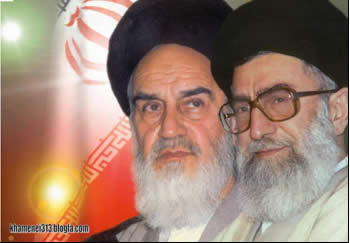
Ayatollah Khamenei (right). Will he be forced to follow the example of his predecessor, Ayatollah Khomeini (left), and drink from the poisoned chalice? (khamenei313.blogfa.com)
Overview
1. On July 17, 2012,Iran commemorated the anniversary of the decision made by Iran’s former Supreme Leader Ayatollah Ruhollah Khomeini to agree to a ceasefire with Iraq. It was a historically significant decision and a strategic departure from Khomeini’s previous stance, which was that the war had to continue until Iraq’s defeat. Khomeini’s strategic decision, which brought an end to the eight-year war between the two countries,was made on the basis of U.N. Security Council Resolution 598 from 1988.
2. The anniversary of Khomeini’s decision was marked by an extensive and rather uncharacteristic discourse by Iran’s media on his agreement to the ceasefire. Top regime officials, including Iran’s current Supreme Leader Ali Khamenei, expressed their support for the difficult decision made by Khomeini and provided explanations to the turn in Khomeini’s stance and Iran’s policy. Supreme Leader Khamenei and other members of the Iranian leadership argued that the turn had been largely the result of domestic reasons, chiefly the economic problems brought on by the sustained fighting, which put Iran in a difficult position and caused considerable suffering to its citizens.
3. With that in mind, we attempted to look into the historic reasons which, at the time, led to Ayatollah Khomeini’s decision. Granted, what we may learn will not necessarily be pertinent to the present circumstances and the set of considerations which guide Khamenei, who directs Iran’s policy in a completely different strategic environment than that of Khomeini, his predecessor. And yet, an examination of the reasons behind Khomeini’s decision may offer us a glimpse into a better understanding of the set of constraints and considerations that influence the Islamic regime in Tehran—which regards Khomeini as its role model—should the time come for it to make a difficult strategic decision that would mean a sharp turn in policy (or “drinking from the poisoned chalice”, as Khomeini once put it).
4. We examined the reasons behind Khomeini’s decision from two perspectives: the way they were portrayed by Khomeini in his letter to top regime officials, and the reasons indicated by historians who studied the Iran-Iraq War. These two (highly consistent) perspectives show that the main reason behind Khomeini’s decision was the difficult military situation brought on by the defeats Iran suffered on the battlefield of the war against Iraq. For Iran, these defeats meant losing territory it had conquered in Iraq, sustaining severe damage to its infrastructure, suffering massive casualties, and experiencing a decline in public morale. This brought Khomeini to believe that the Islamic regime in Iran was facing a no-choice situation, since the fighting, had it persisted, could have jeopardized its very survival. Even though Iran’s economy was badly hit by the war and the country found itself under international pressure, it is our impression that these were all secondary reasons for the difficult decision made by Khomeini.
5. These insights are different than those presented by the Iranian leadership in the media discourse that took place on the anniversary of Khomeini’s decision. The focus in the statements made by Khamenei and other top officials was on the economic problems that had faced Khomeini and the day-to-day difficulties experienced by the Iranian people, playing down the difficult military situation and the low morale. It is our assessment that shifting the focus from the military defeats to the economic difficulties was primarily intended to cast Khomeini, the founder of the Islamic republic and Khamenei’s role model, in a positive light, as a leader who cared about the needs of his people and did not yield to external pressure, and to stave off criticism that his leadership brought Iran to the precipice of collapse.
6. Are these insights relevant to the currently prevailing approaches within the Iranian leadership on the way Iran needs to contend with the pressure exerted by the United States and the West—and if so, to what extent? In our assessment, the precedent set by Khomeini’s decision—a significant turn in Iran’s policy which contradicted his previous strategy and even ideological stance—may be used at some point by Khamenei and the Iranian leadership, if and when the regime believes that its policy is in a dead end and that its survival is at stake. On the other hand, Khamenei and the hardliners may be encouraged by the fact that Iran’s current situation is still much better than the predicament the country was facing in 1988 after eight years of exhausting fighting with Iraq.[1]
7. The following three appendices deal with various aspects of Khomeini’s decision:
i. The chain of events that led to the cessation of fighting between Iran and Iraq
ii. The reasons for Khomeini’s decision according to a letter he sent to top regime officials
iii. The reasons for Khomeini’s decision according to literature on the Iran-Iraq War
* This is a follow-up to our July 26, 2012 Information Bulletin: “Will Iran’s Supreme Leader once again be forced to drink from the poisoned chalice? Iran’s media has recently focused on Ayatollah Khomeini’s agreement to the ceasefire with Iraq in 1988. The media discourse, which expresses unequivocal support for Khomeini’s decision, may indicate an understanding in Iran that the country’s leadership may be required to make another strategic decision on the nuclear issue”.
[1] For more information on the various approaches, see “Will Iran’s Supreme Leader once again be forced to drink from the poisoned chalice?”






